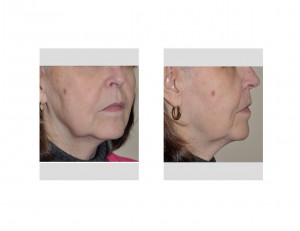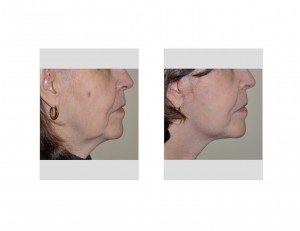
Appearing anytime as early as the mid- to late 40s, jowls are the aging findings on the lower face that many people notice first. Accompanying the jowls may be, and eventually will be, some loose neck skin below the chin. The combination of jowls and neck sagging is the motivation that will drive many people to consider some form of plastic surgery correction.
The plastic surgery procedure to correct jowl and neck aging is a facelift. This is a surprise to many patients as a facelift is usually considered to be a ‘full face’ operation, extending from the scalp down to the bottom of the neck. This is an understandable misconception as the face does extend from the forehead down to the neck. But a facelift operation in the truest sense of the word affects only the lower third of the face, the jowls and the neck.
Case Study: This 62 year-old female from Indianapolis Indiana was bothered by her sagging jowls and dropping neckline. She has undergone in the past year the removal of basal cell carcinomas on one side of her face. These removals left her with some differences in the amount of jowling on the sides of her face with the left side having less jowling than the right side. This jawline asymmetry was also a motivation to have a lower facial correction as well.


While there are many variations of facelift surgery, the most important concern to a patient is to have a procedure that matches their aging problem. In that regard, facelifts can be fundamentally divided into limited vs full varieties. As this patient illustrates, a limited type of facelift is ideal when the jowl and neck concerns are not advanced. This is usually used in younger patients (under 50 years of age) or in those older if their amounts of jowls and neck sagging do not warrant a bigger operation.
Limited facelifts have captured the public’s attention, largely due to how they are marketed and advertised. With numerous marketed names that sound quite catchy, they promise facial improvements with limited downtimes and rapid recoveries. That is true because they are limited facelifts and not extended ones. While there are attempts to differentiate these types of facelifts from each other, and they do have some minor technical differences, the reality is that these surgical maneuver differences have never been proven to make a difference in the outcome of their appearance or in how long the results will last.
Case Highlights:
1) The early signs of facial aging is the appearance of jowls and loose skin in the neck due to descent of tissues due to ligamentous laxity.
2) Limited forms of facelifts are used when jowling is the major facial aging issue to be improved. Some neck benefits are also obtained by the sling effect and with the concomitant use of liposuction.
3) Limited facelifts provide a rapid recovery and can be combined with any other number of other facial procedures such as eyelid and browlifts.
Dr. Barry Eppley
Indianapolis, Indiana


